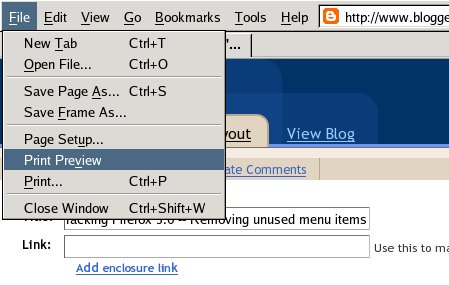
[Nick] sent in his quick hack for getting rid of extra menu options in Firefox 3, like the ever useless ‘Work Offline’ option. (OK, maybe modem lovers like it…) If you’re tired of seeing cluttered menu choices that you never use, [Nick]’s simple trick of editing the XML formatted XUL files in Firefox to clean things up. There’s some risk involved, but it’s nothing that a quick re-install can’t repair. The writeup includes a basic introduction to the XML tags, so you can probably do it. You can use a text editor right? (Just don’t forget to have the installer or a backup copy handy before you start playing around.)
Day: June 17, 2008
Dash Express Now Twittering
Here’s a quick hack to satiate our appetite for location aware applications. The Dash Express is a GPS unit with cellular and WiFi radios so it can do two way communication. Out of the box it can download maps and traffic on the fly. A little while ago they opened up the API so the device could receive info from other web services and owners could give feedback, like reporting speed traps live. The handy hack embedded above publishes your location to Twitter; we would have preferred it hit an actual location service like Brightkite. This just the tip of the iceberg when it comes to possible applications. We wonder what the adoption rate of the Dash Express will be, since the iPhone also has a touchscreen, GPS, and of course a cellular connection.
We’ve got a Dash Express in the lab and it’s based on the OpenMoko design. What sort of tomfoolery would you like to see us do with it? What do you think the killer app for the Dash Express will be?
[via Gizmodo]
Eee PC 901 Teardown

The folks from bit-tech have done us a great service by tearing open the Eee PC 901. Under the keyboard is a large metal plate that acts as the processor’s heat sink. The 4GB SSD card is not soldered to the board this time around. There is some empty space labeled IDE3 and solder points that say 3GCard, which definitely deserve further investigation. The oddest thing they found was a button with no indication to its purpose. It looks like a good machine and we hope to see more Eee PC hacks in the future.
[via Engadget]
World’s Oldest Computer Music Unveiled

Fans of music made with obsolete technology are in for a treat: recordings of a Ferranti Mark 1 computer playing Baa Baa Black Sheep and In the Mood were recently released, and they are thought to be the oldest recordings of computer generated music in existence.
The Ferranti Mark 1 is a commercial version of Manchester University’s SSEM computer (aka Baby), which preceded several more well known computers like UNIVAC and EDVAC. It was one of the first computers that didn’t require a great deal of hardware rewiring to perform different tasks, making it ideal for this sort of purpose. It is not known whether the program was written to play these songs only or for more diverse composition and playback, but the author, [Chris Strachey] was known to be a friend of the legendary [Alan Turing]. The recording was released as part of the Manchester SSEM’s 60th anniversary celebration.
Anonymizing Clothing

Though much of [citizenFinerran]’s intent in designing a suit that camouflages the wearer from security camera footage was philosophical, it is designed with a very tangible purpose in mind. The suit does not provide true camouflage (to say nothing of true invisibility), but it does create enough moving visual obstructions to make the wearer completely anonymous on film. More details on this and other invisibility cloaks after the break.
Mozilla’s First Public Release
[youtube=http://www.youtube.com/watch?v=mZTJbsUcdeU&hl=en&rel=0&color1=0x3a3a3a&color2=0x999999]
In honor of Firefox 3.0 download day, Waxy.org has posted the full Code Rush documentary. It spans March ’98 to April ’99, as the Mozilla team publishes the first source code and then the eventual AOL acquisition of Netscape. Embedded above is a short clip of [Jamie Zawinski] pushing the code live at 10AM on March 31, 1998. The hour documentary is well worth watching.
If you’re unsure about moving from FF2 to 3, MultiFireFox still works perfectly fine with the new release.
Hacking Sleep Part Deux

The Boston Globe recently posted some tips to help you get the most from your naps. The information comes in the form of a chart with numerous facts about naps, including the timeline of events in a typical nap, information about chronotypes, and ideas on how to fall asleep quickly and stay asleep. Since our post on polyphasic sleep, we’ve been interested in sleep techniques that essentially trick the body into feeling as rested as possible (the crudest form of biohacking, in our opinion). Many of these techniques are certainly applicable to polyphasic sleep, but one of the most interesting concepts, chronotypes, is not. Chronotypes are simply profiles of sleep habits that denote the times a person’s body is more readily disposed to fall asleep; since polyphasic sleep requires practitioners to sleep several times a day, it is always in conflict with the person’s chronotype at some point in the day. Nonetheless, the chart should help you stay alive if you ever have several back-to-back intercontinental flights.
[via Lifehacker]











